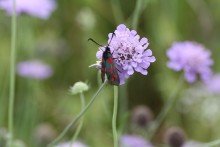My Favourite shrub
The Butterfly Bush, Buddleja davidii of which there are 100 or so species is a summer favourite of mine in the mixed border or in random planted groups. Originating from Asia, Africa North and South America they tend to be large shrubs with pioneering tendencies, particularly on waste ground. Buddleja davidii peaks in August, and I admire its arching loose habit, and adore the fragrant fountain like dense panicles of blue to purple orange centred flowers that grow on shoots produced in the current year. There are no prises for guessing why it is so named the Butterfly bush. The blooms are an abundant source of nectar easily accessible to butterflies (all 22 British species love its nectar) and pollinating insects too. Blue and purple varieties tend to be most common in gardens, with whites and pinks gaining in popularity. Take a few moments to seek out a Buddleja this week and just marvel at the numbers and range of butterflies that will be visiting. I noted at least 20 small tortoiseshell butterflies on a single bush in my garden as well as dozens of honey bees and bumblebees!

Growing & Management Tips
This hardy shrub enjoys fairly dry conditions in sun or partial shade, ideally in in fertile well drained soil. It has quite a pioneering habit, and can readily reach heights in excess of 3m so needs plenty of space to grow true to form. It has recently gained a bit of a reputation for being too prolific in some situations. I don’t necessarily agree, as I think its benefits for pollinators are actually more important. Compact versions have been bred for the smaller gardens. It responds well to pruning in late spring after the worst of the frosts have passed. Spring pruning helps ensure that flowering is timed to August, best for emerging butterflies. Deadheading flowers as they fade encourages a second flush taking flowering well into the autumn.
Why not plant a Buddleja this autumn and enjoy a butterfly festival next summer! If you have lots of space you might like to try growing Buddleja davidii ‘Dartmoor’ (300cmx400cm) which has huge purple/violet panicle flowers, and received the Royal Horticultural Society Award of Garden Merit (AGM) in the 2008-2010 trial. For smaller gardens Buddleja Davidii ‘Sunkissed’ (280cmx290cm) also received an AGM in the same trial. Again large blue mosaic flower panicles are a feature with a strong growing compact habit. When plant shopping do support your local nurseries, and always aim to buy British grown stock.
My Favourite Perennial

The Globe thistle Echinops is a genus of some 120 species of annuals, biennials and perennials. This year I have been blown away by the performance of Echinops bannaticus, a clump forming perennial. It has dense grey woolly stems, spiny hairy grey green leaves and produces beautiful architectural spherical blue flower heads. All bees, butterflies and moths love this plant for its abundance of nectar. And interestingly they will all happily forage alongside one another while doing so. I am thrilled to report that I saw my first sighting of the nationally scarce Jersey Tiger Moth on this plant in my garden only 2 weeks ago!
Growing & Management Tips
Echinops is hardy and will thrive in any poor well drained soil preferring a sunny open aspect. They are ideal inclusions in a large border or wilder garden. It self-sets easily, so you always have a continuous supply of plants for your border! They make great feature cut flowers in posies too. Try planting Echinops bannaticus ‘Taplow Blue’ for its bright blue flowers in a border. For a patio why not plant Echinops ritro ‘Veitch’s Blue’. Both are summer stunners.
My Favourite Wildflower
Devil’s Bit Scabious, Succisa pratensisis the princess of the flower meadow blooming from summer to late autumn. The flowers are rich velvety blue mauve in colour and are held on slight airy stems. Pin cushion like in bud they open to a delicate spherical flower. I never fail to be charmed by them.
Succisa pratensis is a native of Britain and is often found growing wild on moist soils. It has a broad habitat range and will grow in both acid heathland and chalk downland. It is a member of the teasel family, is rich in nectar and pollen and a big hit with bees butterflies and moths. It’s one to look out for now if you are meadow walking.
At Dorset Eye, we would love to know what your favourite plant is, so why not tell us and send us your photos!
Marie McLeish is a gardening coach based in west Dorset. To find out more about the services Marie offers or to get in touch please email; marietmcleish@gmail.com
Twitter @MyGardenCoachUK







